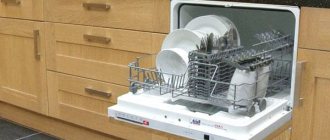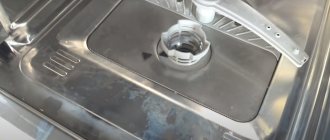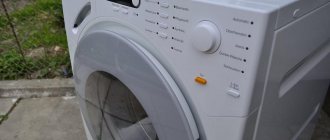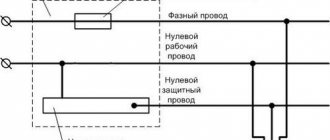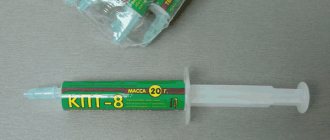How to tell if your dishwasher is on its last legs.
When it comes to kitchen appliances, many people underestimate the dishwasher. Like, why is it needed? I can wash the dishes myself. Here's what the facts say:
- Washing dishes by hand is less effective and leaves more bacteria on the dishes.
- A dishwasher can save you up to 10 days a year of washing dishes by hand.
- An energy-efficient appliance reduces water consumption and therefore utility bills.
So you should definitely think about buying such an assistant for your kitchen. Especially during a pandemic, when each of us wants to be sure that he is using perfectly clean plates and cutlery. And if you already have a dishwasher, you need to carefully monitor its condition.
Appliance experts are unanimous in saying that many dishwashers—perhaps even the one in your kitchen right now—are in desperate need of replacement.
Today we will tell you about 12 signs that will indicate that your dishwasher is already on the verge.
Features of equipment from Electrolux
The brand has earned a reputation as a reliable manufacturer aimed at consumers with middle and high incomes. The company focuses on the minimum level of resource consumption.
Therefore, regardless of the price category to which the model belongs, all dishwashers have only A and higher energy consumption class. Water is also saved – on average, the device spends 2 liters less per cycle than its competitors’ counterparts.
Electrolux engineers try to achieve minimal noise levels for their products. On average it is no more than 45 dB. In addition, a number of models have a function of maximum quiet operation, which can be activated, for example, at night.
The manufacturer produces three main lines of dishwashers:
- REAL LIFE. Large-sized equipment with increased capacity. The volume of some models is increased by 10 liters compared to analogues from other companies. In addition, the designers make it possible to adjust the height of the upper compartment. This allows you to load large kitchen utensils into the machine.
- REAL LIFE SLIM. Compact narrow appliances for small spaces. Despite the dimensions, the organization of the internal space is extremely effective. The devices are quite spacious. The manufacturer paid special attention to the efficiency of washing dishes. The devices feature Satellite technology, which allows water to be sprayed from all sides.
- Green Line. Units operating with maximum resource savings. These models can be connected to hot water, which can significantly reduce energy costs for heating it. However, this increases the consumption of heated water. The total energy consumption of these devices is reduced by 35%.
Leakage protection can be implemented in full or partial versions. In the first case, it applies to the body and hoses, in the second - only to the body.
Complete protection is provided by the AquaControl , which, when a leak is detected inside the housing, cuts off the water supply to the device and disconnects it from the network.
Dishwashers from the Swedish brand are distinguished by their functionality and maximum efficiency. The manufacturer has done everything to ensure that the dishes are washed clean with minimal consumption of resources
The door does not latch
JOHNER IMAGES / GETTY IMAGES
According to repair expert, CEO and founder of Dwelling Nick Ornitz, if your dishwasher door won't latch, it's a wonder the appliance even started . The good news is that the latch can be replaced . If this does not help, most likely the entire machine will have to be replaced.
“If it’s not a simple matter of replacing the latch,” Ornitz says, “the door is likely warped .” This usually results from prolonged exposure to water. To avoid the situation where you load your dishwasher only to find it won't work because of the door - look out for earlier warning signs of leaks and clogs.
You take out cold dishes
SALLY ANSCOMBE/GETTY IMAGES
If hand washing depends on how well you remove stains, dishwashers rely on a spray of hot water for everything . It's unlikely that your hands will be able to withstand the temperature required to properly sanitize utensils as recommended by the FDA, which is just one reason why you shouldn't wash utensils by hand.
Immediately after the dishwasher completes its cycle, your dishes should be hot to the touch . If it doesn't, "there's likely a problem with the heating element inside the machine ," says Rob Shaw, home appliance expert at ProTip. – The heating element is expensive to replace. So if you end up with cold dishes after cleaning, you may need to consider replacing your dishwasher.”
Dishes remain dirty
LA BICICLETA VERMELLA / GETTY IMAGES
You might think that if your dishes come out of the dishwasher with food residue on them, they're done. However, this is not always the case. "If your dishwasher isn't doing its job properly, the first thing you should do is check to see if there are any food particles in the filter , which is located in a cylinder at the bottom of the unit," advises Albert Lee, founder of Home Living Lab. .
"If you don't find anything suspicious, your next step is to thoroughly clean the dishwasher," says Audrey Monell, president of Forrest Anderson Plumbing and Air Conditioning in Glendale, Arizona. You need to remove the filter and wash it with hot, soapy water. And don’t forget to clean the spray nozzle, which could also be clogged.
If the dishes are still dirty, it could be due to hard water or dried-out food . But if you have already tried everything, but to no avail, most likely the problem is in the machine itself. In this (hopeless) case, it is recommended to replace it.
There is a puddle at the bottom of the car
RAGNAR SCHMUCK/GETTY IMAGES
According to Monell, if you open the dishwasher door after a cycle has finished and find water at the bottom, that's a major sign that your mate needs replacing . This means that the dishwasher is not draining water as it should.
But before you buy a new one, check to see if the drain is clogged . If you see a clog, try clearing it yourself using a wire hanger bent into a "U" shape . Also, if you have a food waste disposer, check the disposal drain line to make sure this is not the root of the problem.
"If you don't find any physical obstruction, it's possible that the drain itself is faulty ," Ornitz says. In this case, the only way out is to replace the machine.
Optimal washing temperature
Most modern machines are capable of operating at different temperatures, which depend on the amount and degree of contamination of the loaded kitchenware and the selected washing program. To reliably determine at what degree the equipment copes with its duties most effectively, you need to try all modes of its operation.
Standard
The program is basic and is provided in all PMMs, regardless of manufacturer and price. The mode runs when water is heated to 45–65 °C.
This is quite enough for high-quality and quick washing of slightly and moderately soiled kitchen utensils. Suitable for daily use.
Intensive
A useful function, but, alas, not every home assistant can “boast” of having it. The equipment washes at temperatures of 70 °C and above, so it can easily cope with heavy stains (grease, dried food debris) even on frying pans and pots.
Plus, this program ensures the disinfection of kitchen utensils, as well as the sterilization of cans for preservation. But you shouldn’t abuse it, since it takes longer and is more energy-consuming than any other washing program.
Delicate
To carefully handle items made from fragile materials (porcelain, crystal), dishwashers use the delicate program. In this case, t values do not rise above 40 °C, and the cycle itself lasts from 30 to 100 minutes (depending on the model). For example, in Siemens PMM it takes at least 1 hour and 10 minutes, and in Bosch it takes only 44 minutes.
Do not use delicate mode without a special product that can completely dissolve at 30 °C. Also, do not use it on heavily soiled kitchen appliances. Otherwise, the quality of cleaning will be unsatisfactory.
The car is leaking
IMAGE SOURCE / GETTY IMAGES
If you see a puddle of water on the floor in front of your dishwasher, Monell notes, chances are you've already noticed a puddle at the bottom of the dishwasher . Water on the floor is an even better sign that it's time to replace your dishwasher. Turn off the water supply, wipe the floor and dishwasher dry, and wait for the plumber.
There is rust on the outside of the car
ABLOKHIN / GETTY IMAGES
According to Shaw, rust is never a good sign, no matter whether it's inside or outside the car. "Any time you see rust in your dishwasher or on its surface, it's a sign of a water leak," explains the expert. This may require either expensive plumbing repairs or complete replacement of the unit.
EXPERT OPINION
Irina MEZINTSEVA, sales manager of household appliances:
— A dishwasher makes sense from an economic point of view. Even if you don’t consider the comfort of a housewife an advantage, there are specific figures confirming the benefits of using a dishwasher!
Water meters are increasingly becoming part of our everyday life. Your wallet will clearly confirm the benefits of a dishwasher: hand washing 12 sets of dishes uses about 60 liters of water. And in a car - no more than 14-18 liters. And it turns out that a family of 4 uses a dishwasher to save almost 8 thousand liters of water per year!
BY THE WAY
The number of “sets” that the machine washes is calculated according to foreign standards, namely: 11 items for each person (3 plates, a glass, a cup with a saucer, a knife, a fork and 3 spoons) Plastic and wooden items cannot be placed in the dishwasher, silver utensils, pewter, bone, brass items - high temperatures can have a bad effect on the gilding and painting of old utensils. All this will have to be washed the old fashioned way, by hand.
Rust has formed inside the car
LUMINOLA/GETTY IMAGES
Never ignore rust that has appeared inside your dishwasher! Firstly, this means that there is rust on “clean” dishes . Second, it's a sign that the inside of your dishwasher is worn out or broken into pieces , causing the underlying metal to begin to rust.
One way to quickly diagnose the problem is to run the dishwasher dry and add a spoonful of citric acid to the detergent container . If this doesn't get rid of the rust, call a plumber.
Optimal temperature
Modern machines can operate at different temperatures, “adjusting” to the loaded dishes within a given mode. You can only understand which degree is the most effective through experience - try all the programs offered by the manufacturer .
- Standard wash. This is the basic mode, which is available on both cheap and very expensive models. As a rule, the cycle takes place at 50-60 degrees, which ensures fast and effective removal of contaminants.
- Intensive washing. Not all machines can boast of an intensive program in which loaded plates undergo several stages of high-quality cleaning. The water heats up to 60-80 degrees, which allows the machine to clean and completely disinfect dishes. But it is worth understanding that such cleansing is longer and more energy-consuming than the standard cycle.
- Delicate mode. An additional function designed for gentle washing of fragile materials such as porcelain or crystal. Heating is limited to 40 degrees, and the cycle does not take more than 30 minutes. It is also necessary to use special detergents that dissolve at low temperatures and do not contain abrasive substances.
If dishwashers are equipped with a special dish scanner, the temperature is set automatically.
You can more accurately determine the optimal degree by looking at a special temperature sensor, which is provided in most modern units. If the “thermometer” breaks down, it is better to fix the problem quickly, otherwise the machine will not be as practical and effective as before.
Interesting:
- Dishwasher rating 45 cm
- What is a dishwasher?
- How to connect a dishwasher to hot water
- Korting dishwasher programs
- Are there any savings when using a dishwasher?
- How to use a dishwasher correctly
Reader comments
- Share your opinion - leave a comment
Have you noticed any cracks?
ELENA PEJCHINOVA / GETTY IMAGES
Of course, if you notice a clear crack inside the dishwasher, rust and leaks (even if they haven't appeared yet) are clearly just around the corner .
Scratches and cracks can occur as a result of normal wear and tear or because you put an item that is not dishwasher safe in the dishwasher . If you notice a crack, turn off the water supply and call a plumber immediately to prevent a flood in your home or apartment.
Average dishwasher life
Today you can hardly meet a person who would say that he loves washing dishes. As a rule, people either absolutely do not want to do washing, or do it without much enthusiasm, only because washing dirty dishes simply cannot be avoided. That's why Beko and Electrolux dishwashers were invented.
The benefits of this invention have been recognized by millions of consumers around the world. It can save a huge amount of hours and energy that can be spent on something more important. For example, on vacation with family, shopping and much more.
Dishwasher (45 cm) Electrolux
If you don't have Indesit in your home yet, you're missing out! However, it is not enough just to purchase it. To ensure long-term and uninterrupted operation of Ariston, maintenance of the machine is necessary. This is quite easy to implement; you just need to adhere to certain maintenance and maintenance principles, and the service life of the Bosch dishwasher will be increased by several years.
Dishwasher Indesit
Dishwasher makes strange noises
WAVEBREAKMEDIA LTD / GETTY IMAGES
Even the quietest dishwashers make noise when they enter the rinse cycle . But if it seems unusual to you, turn off the device and find the source of the sound .
Perhaps it comes from the impact of utensils against each other. Or the culprit is some part of the device. If you do not find obvious reasons, you can assume that the problem is in the engine . In this case, repairing or replacing it may cost you more than buying a new car.
Machine is not Energy Star certified
LA BICICLETA VERMELLA / GETTY IMAGES
“If your dishwasher is not Energy Star certified, you may want to consider replacing it right away. It doesn't matter whether you have problems or not,” says Darryl Webber, Ph.D., chairman of the Department of Mechanical and Aerospace Engineering at Trine University in Angola, Indiana.
Dishwashers began being labeled in June 1996 to designate appliances that are at least 12% more efficient than non-certified models and more efficient than models that meet a minimum “energy efficiency” standard.
Washing dishes in a new Energy Star-certified dishwasher instead of washing by hand will save you an average of 14,000 liters of water over its lifetime , and therefore reduce your utility costs.
What needs to be done to prevent the dishwasher from breaking down prematurely?
The service life of a dishwasher should be indicated in the operating instructions, Oleg Dranitsky, head of the certification body for household appliances Testbat, told “If it is not specified, then it is 10 years under the Law “On the Protection of Consumer Rights,” Article 7,” the expert added. To ensure that the dishwasher does not break down before this time, the expert advises adhering to a number of rules.
Clean dishes from food residues before loading
Before you put your dishes in the machine, you need to prepare them. To do this, you should clean plates, cutlery and other items from food debris. “This only applies to large contaminants - large solid pieces of food. They may clog the filter and you will have to clean it. Or they can even stop the drain, and the machine will fill with water. But a technically advanced machine will most likely stop and show an error number,” Dranitsky explained. At the same time, there is no need to pre-rinse the dishes; it is enough to throw away the garbage from them, he emphasized.
Main on plates. Dishwasher rating Read more
Properly wash rubber gaskets on car doors
“Gaskets need to be washed if there is noticeable dirt on them, so that microorganisms do not multiply,” noted Oleg Dranitsky. To do this, you can use any detergent or, if possible, just water.
Some housewives recommend washing pads with a solution of vinegar or citric acid, but the expert does not recommend using such “folk” recipes. “I don’t recommend using acids - they can corrode the rubber and it will crack,” he explained.
Turn on the machine regularly
The dishwasher must be used regularly. “Every day is normal, that’s what it’s made for. It can happen more often, nothing will happen to her. Downtime is worse for her - gaskets, hoses and other parts begin to dry out,” Dranitsky said. According to him, if the dishwasher is idle, once a month you can run it on a normal cycle with a standard “tablet”.
Also, do not be afraid of overload. “It’s impossible to overload a dishwasher; it’s not a washing machine. You cannot load more than one plate into a cell, and as long as the dishes are evenly placed in the baskets, there will be no overload,” the expert explained.
How to get rid of old equipment in an apartment? More details
Use a special detergent
Trying to run the machine with detergent intended for hand washing dishes may damage the machine. Therefore, in this case, the use of a special tool is mandatory. At the same time, the choice of a specific brand or form of detergent has virtually no effect on the service life of equipment, the expert believes. “There are a lot of good products on sale now. The most convenient tablets are two in one, three in one, five in one, etc. They contain salt, detergent, and rinse aid,” he noted.
